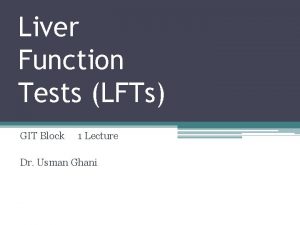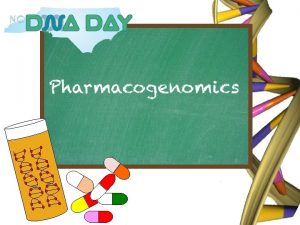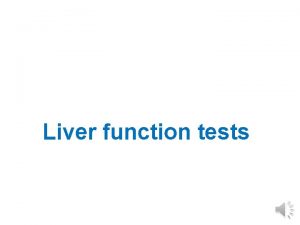Liver Function Tests and Therapeutic Drug Monitoring in


- Slides: 2


Liver Function Tests and Therapeutic Drug Monitoring in Schizophrenic Patients on Quetiapine Combination Therapy n It was reported that quetiapine (QTP)-treated patients presented asymptomatic liver dysfunction and new-onset diabetes mellitus. It was also shown that QTP treatment may change metabolic parameters of schizophrenic patients with or without hyperglycemia differently. Blood glucose controls of oral antidiabetics may be improved while diabetic patients co-medicated with silymarin (SB). The purpose of this study was to monitor the liver function changes and therapeutic drug concentrations after QTP treatments, and after QTP co-medicated with SB treatments in Taiwanese schizophrenic patients. This clinical trial was approved by Taipei Medical University Institutional Review Board and each patient’s informed consent was obtained. This study was conducted in a private long-term care facility in Taipei, Taiwan, and patients diagnosed with schizophrenia were recruited. Study design: QTP dosage was titrated up to 300 mg/day within one week. Patients were maintained on this dose until the end of the study. SB (70 mg/day) was added on from day 15 to day 22. Blood samples were collected from patients at day 1, 15, and 22 to test metabolic parameters and liver function. Samples of day 15 and 22 were further analyzed for QTP therapeutic drug monitoring (TDM) at 0~8 hours postdose. There were thirteen patients recruited, and their average and body weight were 46. 6 ± 10. 8 years old and 66. 6 ± 9. 5 kg, respectively. After three patients cotreated with clozapine were excluded, patients’ (n=10) average and body weight were 48. 9 ± 11. 3 years old and 65. 9 ± 9. 4 kg, respectively. Results: After 2 weeks of QTP treatment (day 15), the patients’ average postprandial insulin levels (PPI) decreased significantly (p=0. 03) while number of quantitative insulin sensitivity check index (QUICKI) decreased and fasting insulin concentration increased. There were ten patients whose aspartate aminotransferase (AST) or alanine aminotransferase (ALT) increased more than 10% at day 15. Fasting insulin concentration and QUICKI of samples collected at day 22 decreased or increased, respectively, when compared to those collected at day 15. There were only three patients whose AST or ALT increased more than 10% at day 22. There were no significant differences in QTP TDM and pharmacokinetic parameters following QTP treatments with or without SB whether patients using clozapine or not. Furthermore, according to their day-1 fasting plasma glucose (FPG), patients were subgrouped into non-hyperglycemic group or hyperglycemics (FPG≧ 100 mg/d. L). In non-hyperglycemic schizophrenic group, there were four patients whose AST or ALT increased more than 10% at day 15, but there was no one had increased AST or ALT more than 10% at day 22. Average peak QTP concentration (Cmax) of hyperglycemic patients were lower than the non-hyperglycemic patients (p=0. 04). However, when patients cotreated QTP and SB, the average Cmax became similar between two groups. Moreover, at day 22, total cholesterol levels were statistical significantly higher (p=0. 04), but still within normal ranges, than that of samples collected on day 15 in hyperglycemic patients. Mean volume of distribution of the non-hyperglycemic patients was significantly lower (p=0. 03) at day 22 than that of samples collected on day 15. The results suggest that: (1) Number of schizophrenic patients with liver function abnormality observed after QTP treatment may be reduced when SB was co-administered for one week, especially in non-hyperglycemic patients. (2) There was no need to adjust QTP therapeutic dosage in non-hyperglycemic schizophrenic patients when the duration of their combination treatment of QTP (300 mg/day) with SB (70 mg/day) was no longer than one week. But TDM for QTP is suggested in schizophrenic patients with hyperglycemia.



